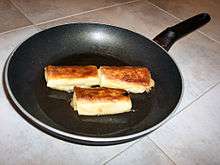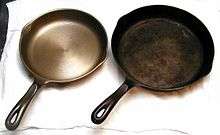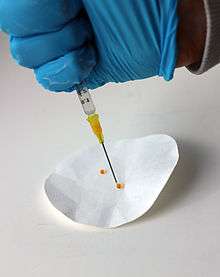Non-stick surface
A non-stick surface is a surface engineered to reduce the ability of other materials to stick to it. Non-stick cookware is a common application, where the non-stick coating allows food to brown without sticking to the pan. Non-stick is often used to refer to surfaces coated with polytetrafluoroethylene (PTFE), a well-known brand of which is Teflon. In the twenty-first century, other coatings have been marketed as non-stick, such as anodized aluminium, ceramics, silicone, enameled cast iron, and seasoned cookware.

Types
Ancient Greece
The Mycenaean Greeks might have used non-stick pans to make bread more than 3,000 years ago. Mycenaean ceramic griddles had one smooth side and one side covered with tiny holes. The bread was probably placed on the side with the holes, since the dough tended to stick when cooked on the smooth side of the pan. The holes seem to be an ancient non-sticking technology, ensuring that oil spread evenly over the griddle.[1][2]
Seasoning

Cast iron,[3] carbon steel,[4] cast aluminium and stainless steel cookware may be seasoned before cooking by applying a fat to the surface and heating it to polymerize it. This produces a dry, hard, smooth, hydrophobic coating, which is non-stick when food is cooked in conjunction with a small amount of cooking oil or fat.
Fluoropolymer
The modern non-stick pans were made using a coating of Teflon (polytetrafluoroethylene or PTFE). PTFE was invented serendipitously by Roy Plunkett in 1938,[5][6] while working for a joint venture of the DuPont company. The substance was found to have several unique properties, including very good corrosion-resistance and the lowest coefficient of friction of any substance yet manufactured. PTFE was first used to make seals resistant to the uranium hexafluoride gas used in development of the atomic bomb during World War II, and was regarded as a military secret. Dupont registered the Teflon trademark in 1944 and soon began planning for post-war commercial use of the new product.[7]
By 1951 Dupont had developed applications for Teflon in commercial bread and cookie-making; however, the company avoided the market for consumer cookware due to potential problems associated with release of toxic gases if stove-top pans were overheated in inadequately ventilated spaces. While working at DuPont, NYU Tandon School of Engineering alumnus John Gilbert was asked to evaluate a newly- developed material called Teflon. His experiments using the fluorinated polymer as a surface coating for pots and pans helped usher in a revolution in non-stick cookware.[8][9]
A few years later, a French engineer had begun coating his fishing gear with Teflon to prevent tangles. His wife Colette suggested using the same method to coat her cooking pans. The idea was successful and a French patent was granted for the process in 1954. The Tefal company was formed in 1956 to manufacture non-stick pans.[7]
Not all non-stick pans use Teflon; other non-stick coatings have become available. For example, a mixture of titanium and ceramic can be sandblasted onto the pan surface, and then fired at 2,000 °C (3,630 °F) to produce a non-stick ceramic coating.[10]
PTFE (Teflon)
Polytetrafluoroethylene (PTFE) is a synthetic fluoropolymer used in various applications including non-stick coatings. Teflon is a brand of PTFE, often used as a generic term for PTFE. The metallic substrate is roughened by abrasive blasting, then sometimes electric-arc sprayed with stainless steel.[11][12] The irregular surface promotes adhesion of the PTFE and also resists abrasion of the PTFE.[13] Then one to seven layers of PTFE are sprayed or rolled on, with a larger number of layers and spraying being better. The number and thickness of the layers and quality of the material determine the quality of the non-stick coating.[14] Better-quality coatings are more durable, and less likely to peel and flake, and keep their non-stick properties for longer. Any PTFE-based coating will rapidly lose its non-stick properties if overheated; all manufacturers recommend that temperatures be kept below, typically, 260 °C (500 °F).[15]
Utensils used with PTFE-coated pans can scratch the coating, if the utensils are harder than the coating; this can be prevented by using non-metallic (usually plastic or wood) cooking tools.
Health concerns
When pans are overheated beyond approximately 350 °C (660 °F) the PTFE coating begins to dissociate, releasing hydrofluoric acid and a variety of organofluorine compounds which can cause polymer fume fever in humans and can be lethal to birds. Concerns have been raised over the possible negative effects of using PTFE-coated cooking pans.[7][16][17][18]
Processing of PTFE in the past used to include PFOA as an emulsifier; however, PFOA is a persistent organic pollutant and poses both environmental and health concerns, and is now being phased out of use in PTFE processing.[19]
PFOA is now replaced by the GenX product manufactured by the DuPont spin-off Chemours, which seems to pose similar health issues as the now banned PFOA.[20]
Culinary uses and limitations
With other types of pans, some oil or fat is required to prevent hot food from sticking to the pan's surface. Food does not have the same tendency to stick to a non-stick surface; pans can be used with less, or no oil, and are easier to clean as residues do not stick to the surface.
According to writer Tony Polombo, pans that are not non-stick are better for producing pan gravy, because the fond (the caramelized drippings that stick to the pan when meat is cooked) sticks to them, and can be turned into pan gravy by deglazing them—dissolving them in liquid.[21]
Superhydrophobic
A superhydrophobic coating is a thin surface layer that repels water. It is made from superhydrophobic (ultrahydrophobicity) materials. Droplets hitting this kind of coating can fully rebound.[22][23] Generally speaking, superhydrophobic coatings are made from composite materials where one component provides the roughness and the other provides low surface energy.[24]

Liquid-impregnated surface
A liquid-impregnated surface consists of two distinct layers. The first is a highly textured or porous substrate with features spaced sufficiently close to stably contain the second layer which is an impregnating liquid that fills in the spaces between the features.[25] The liquid must have a surface energy well-matched to the substrate in order to form a stable film.[26] These surfaces bioimitate the carnivorous Venezuelan Pitcher Plant, which uses microscale hairs to create a water slide that causes ants to slip to their death. Slippery surfaces are finding applications in commercial products, anti-fouling surfaces, anti-icing and biofilm-resistant medical devices.
References
- Ancient Greeks Used Portable Grills at Their Picnics, LiveScience
- How to Cook Like a Mycenaean, Archaeology Magazine
- "Chemistry of Cast Iron Seasoning". Retrieved 2014-11-19.
- How to Season a Wok- Serious Eats
- "Roy J. Plunkett". Science History Institute. Retrieved 21 February 2018.
- Center for Oral History. "Roy J. Plunkett". Science History Institute. Retrieved 21 February 2018.
- Anne Cooper Funderburg. "Making Teflon Stick". Invention and Technology Magazine. Summer 2000. 16 (1). Retrieved 2015-02-21.
- "Inspired by teflon, researchers create super durable proteins".
- "Invention, Innovation and Entrepreneurship Begin at the NYU Polytechnic School of Engineering".
- Pennie Stoyles and Peter Pentland (2007). "Non-stick pan". A to Z of Inventions and Inventors: M to P. Black Rabbit Books. pp. 17. ISBN 9781583407899.
- Nicholas J. Wall, US 5069937 "Thermal spraying of stainless steel", 1988
- Laurence W. McKeen, Fluorinated coatings and finishes handbook, 2006, p. 117
- Excalibur brochure, PDF
- "Cooking For Engineers". Cookingforengineers.com. Retrieved 23 January 2016.
- "Cookware Safety by Teflon nonstick coatings". Chemours Web site. Retrieved 23 January 2016.
- "Safety of Teflon Non-Stick Coatings for Cookware". DuPont. Archived from the original on 2008-01-17. Retrieved 2009-05-06.
- American Cancer Society, Teflon and Perfluorooctanoic Acid (PFOA)
- Tugend, Alina (October 14, 2006). "Teflon Is Great for Politicians, but Is It Safe for Regular People?". New York Times. Retrieved 15 September 2013.
- Juliet Eilperin: Harmful Teflon Chemical To Be Eliminated by 2015. The Washington Post, 2006-01-26
- "Basic Information on PFAS". PFOA, PFOS and Other PFASs. Washington, D.C.: U.S. Environmental Protection Agency (EPA). 2018-02-18.
- Tony Polombo (2006). "Pots and Pans". Cooking. iUniverse. p. 20. ISBN 9780595378661.
- Richard, Denis, Christophe Clanet, and David Quéré. "Surface phenomena: Contact time of a bouncing drop." Nature 417.6891 (2002): 811-811
- Yahua Liu, Lisa Moevius, Xinpeng Xu,Tiezheng Qian, Julia M Yeomans, Zuankai Wang. "Pancake bouncing on superhydrophobic surfaces." Nature Physics, 10, 515-519 (2014)
- Simpson, John T.; Hunter, Scott R.; Aytug, Tolga (2015). "Superhydrophobic materials and coatings: a review". Reports on Progress in Physics. 78 (8): 086501. doi:10.1088/0034-4885/78/8/086501. PMID 26181655.
- "US Patent # US 20130032316 A1". US Patent. USPTO. Retrieved 18 October 2013.
- Aizenberg, Joanna; Grinthal, Alison; Hatton, Benjamin D.; Smythe, Elizabeth J.; Tang, Sindy K. Y.; Kang, Sung Hoon; Wong, Tak-Sing (September 2011). "Bioinspired self-repairing slippery surfaces with pressure-stable omniphobicity". Nature. 477 (7365): 443–447. doi:10.1038/nature10447. ISSN 1476-4687. PMID 21938066.